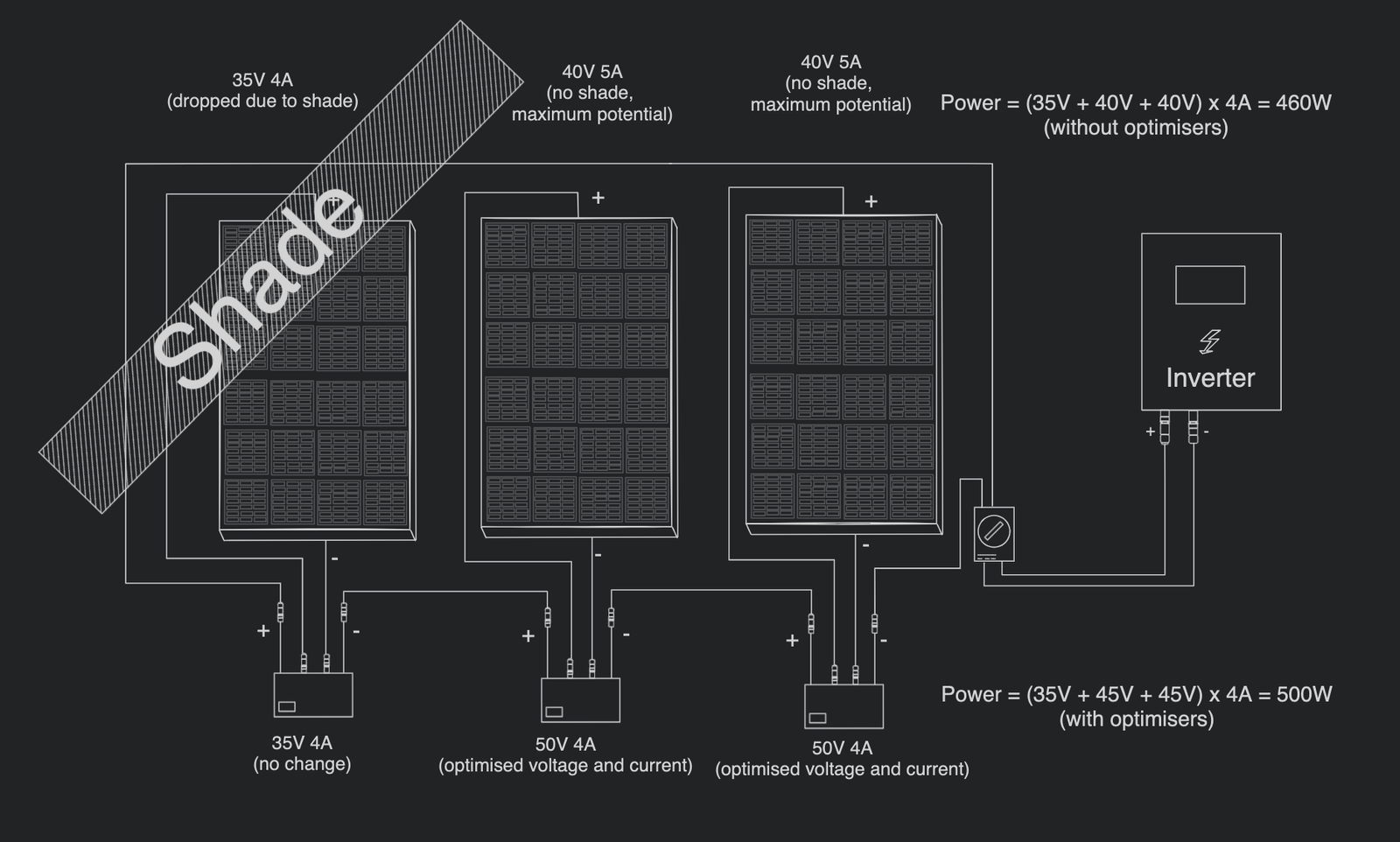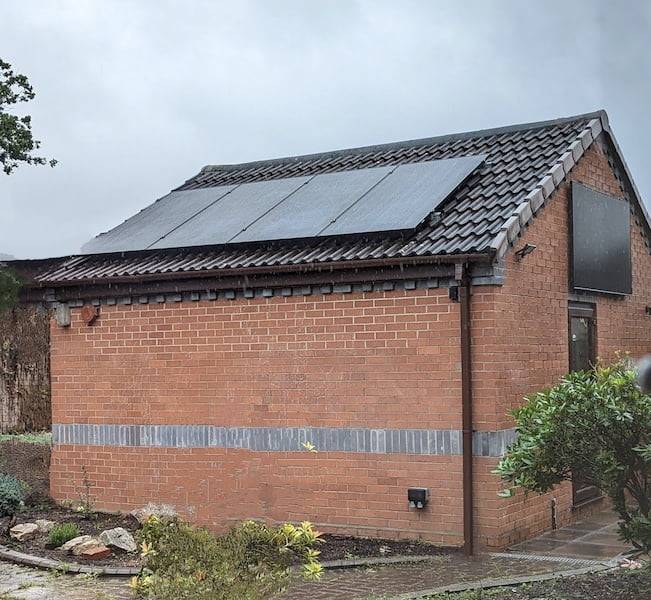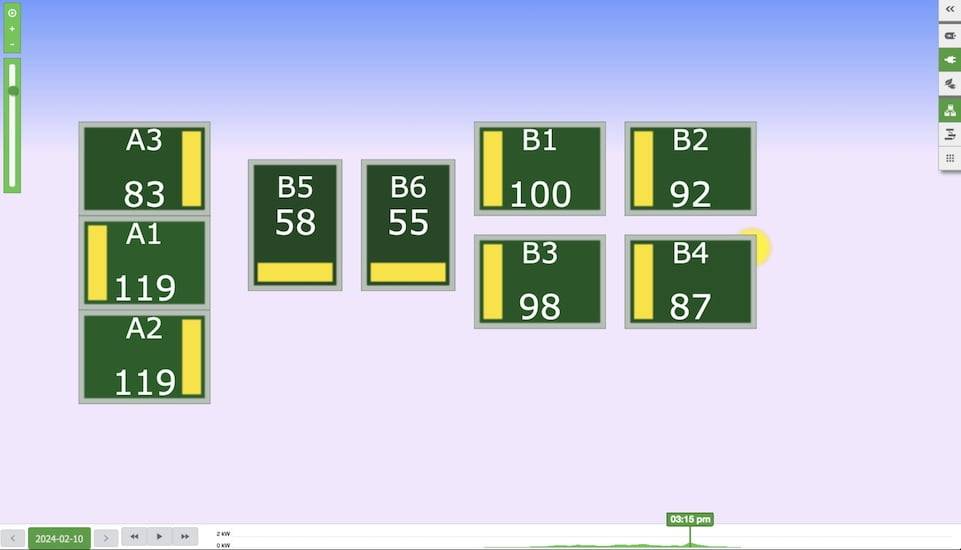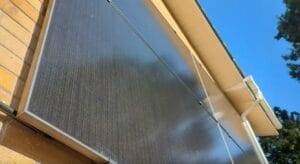Discover how solar power optimisers enhance the efficiency of solar panels, even in intermittent shade and mixed orientation. Learn to harness solar energy effectively regardless of the climate.

Solar power has emerged as a leading renewable energy source, but many potential adopters often wonder: Can you still get solar power on a cloudy day? What about installing panels in a place of intermittent shading? That would affect the whole string right? These are valid concerns. The efficiency of solar panels is indeed affected by factors like cloud cover and shading. However, you can manage and mitigate this effect, too. Solar Power Optimisers, a.k.a. Solar PV Optimisers or Solar Panel Optimisers, can do this mitigation.
Solar PV Optimisers and Shading
Shading is a common issue for solar panel owners. It is especially prominent in urban environments or areas with tall trees. The worst part is that it creates a knock-on effect. Even a tiny amount of shade on one panel can significantly reduce the output of a whole string. However, solar PV optimisers can help mitigate some of the shading effects.

Solar Power Optimisers adjust the voltage for each panel to get the most power possible, given the constraint around the reduced current.
How Solar Panel Optimisers Mitigate Solar Panels Shading
Let’s consider a string of three solar panels with rated voltage 40V and current 5A each. One panel gets partially shaded. It drops to 35V 4A while the rest are still capable of producing 40V 5A. In a string without solar panel optimisers, the entire string would be limited to 4A and the sum of voltages (35V + 40V + 40V).
Optimal Performance for Individual Panels
With solar panel optimisers, each panel can operate at its Maximum Power Point (MPP) within the constraint of the 4A current. This means the panel optimisers would adjust the voltage of the unaffected panels to be higher than 40V to maximise their power output at the reduced 4A.

Solar Power Optimisers and Panel Orientation
When installing solar panels, it’s not always possible to have all panels facing the same direction or having the same tilt angle due to the layout of the roof or other obstructions. This can lead to different panels receiving different amounts of sunlight and thus producing different amounts of power.
With solar panel optimisers, each panel operates independently at its MPP, regardless of its orientation. This means that even if panels are facing different directions, each one can still operate at its maximum efficiency. This flexibility allows for more complex system designs and can make solar power a viable option in situations where it might not have been otherwise.
Do Solar Power Optimisers Help on Cloudy Days?
Solar panel optimisers are great at mitigating the knock-on effects from underperforming subsections of an entire string but don’t work so well, when the conditions are uniform.
A study by the University of Southern Denmark found that on cloudy, days solar panel optimisers did not help but negatively impacted the efficiency of solar panels. The observed efficiency with solar panel optimisers is 99.3% for one brand of optimisers and 98.9% as opposed to 100% with a modern solar inverter.
However, the efficiency figure should be weighed against the following factors:
- Expected cloudy days
- Expected level of uniformity of the cloud effect
- Other partial string disruptors
The same study found that solar panel optimisers are beneficial when mixing in a panel with a different orientation.
Understanding Solar Panel Power Optimisers
Solar power optimisers are compact electronic devices that seamlessly integrate with solar panels. They attach to the back of a panel and feature input connectors that link to the panel’s existing connectors.

They provide another set of connectors as output for connecting to the next panel. Effectively, they sit between the panel and the string, allowing them to manage each panel individually.
Solar power optimisers are DC/DC converters that adjust the voltage and current from a solar panel to maximise its output power. They continuously track individual panels’ Maximum Power Point (MPP). Here’s a breakdown of how they work:
- Voltage and Current Sensing: The optimiser continuously measures the voltage and current output of the solar panel.
- Maximum Power Point (MPP) Tracking: The optimiser calculates the MPP for that specific panel at that particular moment using these measurements.
- DC/DC Conversion: Once the MPP is identified, the optimiser adjusts the DC output using a buckboost converter to align it with the MPP. This ensures that the panel operates at its peak efficiency.
- Output to Inverter: The optimised DC output is then sent to the central inverter, where it is converted to AC for use in the home or grid.
- Communication: Many optimisers have built-in communication features that send performance data to a central monitoring system. This allows for real-time tracking and troubleshooting.
 Tigo will show you in real-time how much power are you getting from individual panels.
Tigo will show you in real-time how much power are you getting from individual panels. - Safety Features: Some optimisers can also reduce the panel’s output voltage to a safe level when the inverter is not operating or during maintenance, enhancing system safety.
The Role of Maximum Power Point Tracking MPPT
Maximum Power Point Tracking (MPPT) at panel level is crucial because individual solar panels are affected differently by factors like temperature, shading, and ageing, which can move the MPP. Here’s how individual panel MPP tracking interacts with the rest of the panels in a string:
- Individual Panel Monitoring: Each optimiser attached to a solar panel continuously monitors that panel’s output and adjusts its voltage and current to operate at the MPP.
- String Aggregation: In a traditional string without optimisers, all panels are affected by the weakest one in the string. If one panel is shaded or underperforming, the entire string’s output drops. With optimisers, each panel operates independently at its MPP, mitigating this issue.
- Data Synchronisation: The optimisers often communicate with a central inverter or monitoring system. This ensures that the inverter operates at the global MPP for the entire string, which may be different from the MPP of individual panels.
- Balanced Output: Because each panel operates at its MPP, the string of panels can produce a more consistent and higher output, making the system more efficient overall.
- Dynamic Adjustment: As environmental conditions change (e.g., partial cloud cover, debris, or the angle of the sun), the optimisers dynamically adjust the panel’s operating point to stay at the MPP, ensuring optimal performance throughout the day.
- Compatibility: Optimisers allow for a more flexible system design, as panels with different orientations, types, or ages can be included in the same string without negatively affecting the overall system performance.
Conclusion
Solar power optimisers play a crucial role in maximising the efficiency of solar panels, especially in challenging conditions like shading, varying panel orientations and angles or partial cloud cover. By continuously tracking and adjusting to the Maximum Power Point of each panel, they ensure that each panel operates at its peak efficiency, leading to a more consistent and higher overall output. Whether you’re considering installing solar panels in the cloudy UK or dealing with intermittent shading, solar power optimisers can help you get the most out of your solar energy system.

 Tigo will show you in real-time how much power are you getting from individual panels.
Tigo will show you in real-time how much power are you getting from individual panels.







